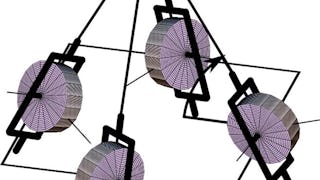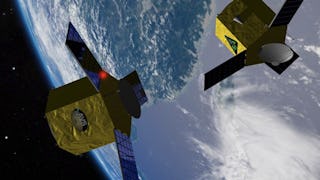This is the 3rd and final course of the spacecraft relative motion course sequence. This course presents a capstone design challenge where you get to develop, simulate and study how to approach a tumbling debris object. The servicer starts from far away and carefully does a series of maneuver to get closer and closer in a safe manner. As the debris object is tumbling, the servicer will have to account for relative attitude motion as well. The final approach is in a debris body-fixed manner illustrating a case of controlling non-Keplerian motion.

Gain next-level skills with Coursera Plus for $199 (regularly $399). Save now.

Spacecraft Formation Flying and Control Capstone Project
This course is part of Spacecraft Formation Relative Orbits Specialization

Instructor: Hanspeter Schaub
Included with
What you'll learn
Develop long range approach trajectory for a rendezvous maneuver
Simulated relative motion control solutions in LVLH frame
Implement non-Keplerian relative motion reference trajectories to fly in a body-fixed manner relative to the debris object.
Skills you'll gain
Details to know

Add to your LinkedIn profile
8 assignments
See how employees at top companies are mastering in-demand skills

Build your subject-matter expertise
- Learn new concepts from industry experts
- Gain a foundational understanding of a subject or tool
- Develop job-relevant skills with hands-on projects
- Earn a shareable career certificate

There are 4 modules in this course
Welcome to the capstone project of the course sequence on spacecraft formation flying dynamics and control.
What's included
1 video
In this module we study how to use a Hohmann transfer to maneuver a servicer spacecraft close to a space debris object. The debris is in a circular orbit with a different radius. Here we study how much fuel such a maneuver will take, the required phasing angle, as well as look at the final maneuver trajectory motion as seen by the chief LVLH frame to determine the smallest miss distance to the debris object.
What's included
1 reading2 assignments
Here we investigate slowly approaching the debris object. We start with a basic drifting orbit and then look at a safety spiral about the debris object.
What's included
3 assignments
Next we are ready to begin our final approach to the debris object. Sadly, the debris object is not holding a steady attitude, but rather it is tumbling. This complicates are final approach as we must control our relative to the debris body-fixed frame to ensure we approach the debris grappling point without colliding in it. What fun!
What's included
3 assignments
Earn a career certificate
Add this credential to your LinkedIn profile, resume, or CV. Share it on social media and in your performance review.
Instructor

Offered by
Explore more from Physics and Astronomy
 Status: Free Trial
Status: Free TrialUniversity of Colorado Boulder
 Status: Free Trial
Status: Free TrialUniversity of Colorado Boulder
 Status: Free Trial
Status: Free TrialUniversity of Colorado Boulder
 Status: Free Trial
Status: Free TrialUniversity of Colorado Boulder
Why people choose Coursera for their career




Frequently asked questions
To access the course materials, assignments and to earn a Certificate, you will need to purchase the Certificate experience when you enroll in a course. You can try a Free Trial instead, or apply for Financial Aid. The course may offer 'Full Course, No Certificate' instead. This option lets you see all course materials, submit required assessments, and get a final grade. This also means that you will not be able to purchase a Certificate experience.
When you enroll in the course, you get access to all of the courses in the Specialization, and you earn a certificate when you complete the work. Your electronic Certificate will be added to your Accomplishments page - from there, you can print your Certificate or add it to your LinkedIn profile.
Yes. In select learning programs, you can apply for financial aid or a scholarship if you can’t afford the enrollment fee. If fin aid or scholarship is available for your learning program selection, you’ll find a link to apply on the description page.
More questions
Financial aid available,





